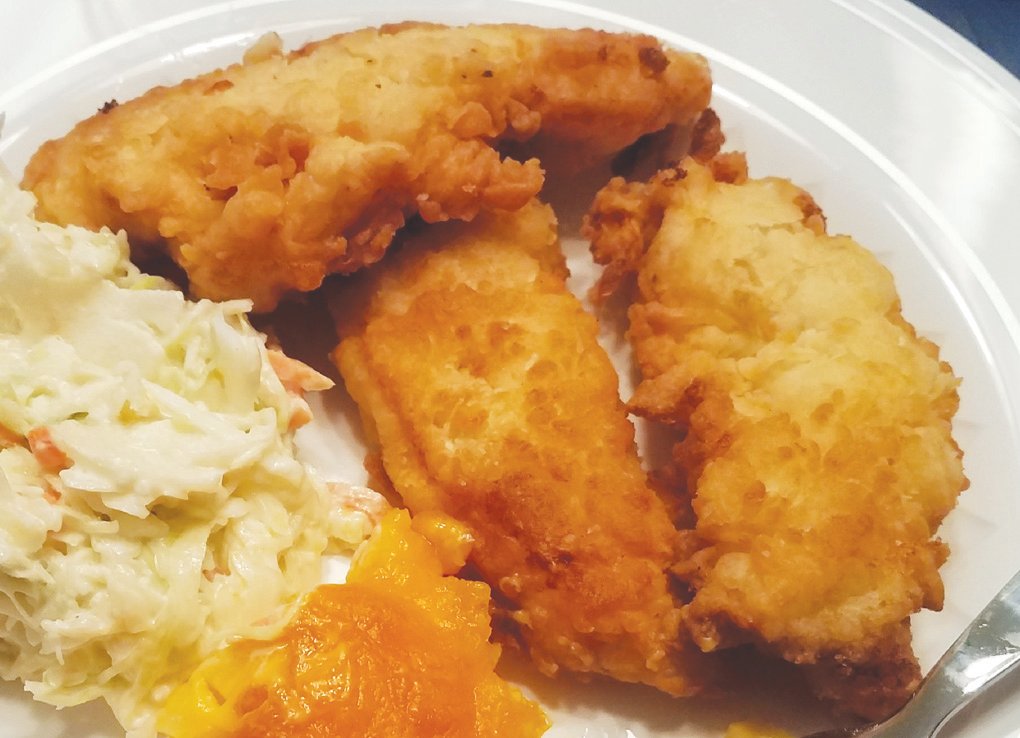
“There is no way to cook juicy chicken breasts.”
“Frying skinless chicken makes it tough and dry.”
“There is no way to know chicken is cooked through without poking it with a thermometer or cutting into it.”
“Chicken tenders are the boring tasteless food of children and childish palates.”
False. False. False. And, false.
The chicken recipe I developed produce tenders that are delicious and always cooked to juicy perfection.
For my birthday, my mom used to make fried, skinless chicken breasts with Hollandaise. For the breading, she used flour. The resulting coating had a smooth, almost silky mouth feel. But it wasn’t terribly crispy and it tended to fall off. And, to make sure the chicken was cooked through, it was often overcooked and dry — hence the drenching of Hollandaise.
As I learned to cook and learned the history, technique, and chemistry that it can entail, I discovered that the tang in buttermilk comes from acid. The leavening in baking powder, which is what makes self-rising flour rise, is activated by acid.
When the tenders are coated in the buttermilk/self-rising flour combo, the resulting crust is what some restaurants call “extra-crispy.” It’s light and crunchy on the outside, which stays on through frying, dunking, and eating. The buttermilk tang can also mask any faint baking powder flavor.
But we still have the problem of making sure the chicken is cooked through, yet still juicy and flavorful.
You may have seen online a photo of one poor benighted soul’s attempt at recipe creation. They can’t understand why no one knew of the joys of rare chicken. The photo was of a chicken breast with a large band of uncooked pink flesh running through the middle.
The reason why no one espouses the eating of pink chicken is that unless a clucker is cooked through to a minimum temperature of 165 degrees Fahrenheit, it can kill.
I am not fooling, exaggerating, or messing around. If you learn nothing else from the curious cook, Gentle Reader, do not, under any circumstances, cook, eat, or serve pink chicken.
“Raw chicken — as well as its juices — are often contaminated with campylobacter bacteria and sometimes with salmonella and clostridium perfringens,” says Jennifer L. Bonheur, M.D., gastroenterologist in New York City.
Even if you’re lucky enough to avoid death from the tiny little tricksters, they can make you sick enough to wish for it. The very young, elderly and those with compromised immune systems are much more at risk for complications.
165° Fahrenheit. No lower—ever.
If your oil is at 350° F, comes up to the top of the tender without covering it, cooks ’til it’s golden-brown on both sides, it will be cooked through. It will also never be overcooked, but ridiculously juicy.
That combination of factors seems to be the sweet spot for flavor, texture and safety.
This technique can also be used for whole chicken pieces, both with and without skin. But you must remove the chicken from the skillet and cook it on the cooling rack over a sheet pan at 350° until the internal temp reaches 165°. And you must use a probe thermometer to make absolutely sure.
I must be honest, cooking tenders in this fashion is both messy and labor-intensive. Because of this, the Matthews Family Band eats this much less frequently than we would like.
But these are truthfully the best tenders you will ever put into your chicken hole, with none of the uncertainty that cooking these birds can sometimes bring.
So before you do the drive-thru or the frozen, pre-packaged parts of parts one more time, let your family in on my secret.
Thanks for your time.
Contact me at debbie@bullcity.mom.
Needed equipment:
Set oven to lowest temp, place pan, and cooling rack inside. Place flour in one shallow pan, buttermilk in another. Heavily season buttermilk with salt and pepper. Place both near cooktop. Remove chicken from fridge and set on plate near flour and buttermilk.
Place skillet on burner and fill to 1/3 full with clean vegetable oil. Heat to 350°.
As oil comes to temp, begin breading tenders, but not before; the buttermilk activates the leavening in the flour. If you prebread, the leavening will have been exhausted and you won’t get the light uber-crispy texture in the finished product.
Using one pair of tongs for the coating and one to handle the cooked chicken, coat each piece in flour, buttermilk, and then again in the flour. Place four tenders at a time in oil, turning burner up slightly so the temp doesn’t drop too much. Cook until golden brown. Flip, and cook other side until golden.
Place cooked chicken in oven to keep warm until all of the tenders are cooked.
Serve with honey mustard, ranch dressing, dip of choice, or a spritz of fresh lemon juice. A green salad is a good side for this fried dish of which you will probably overindulge.